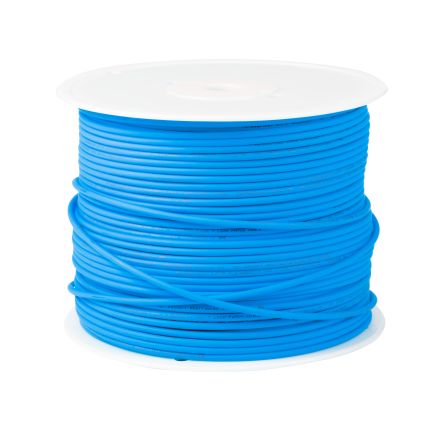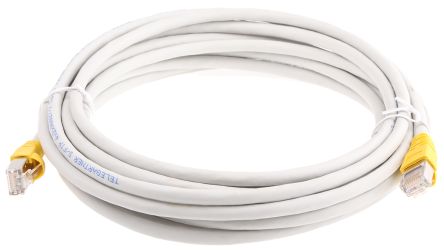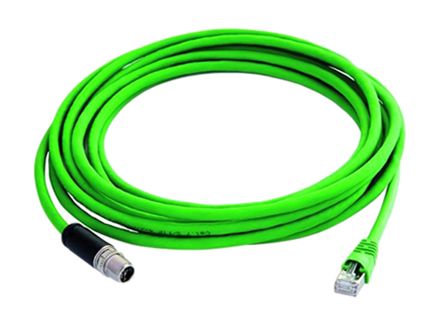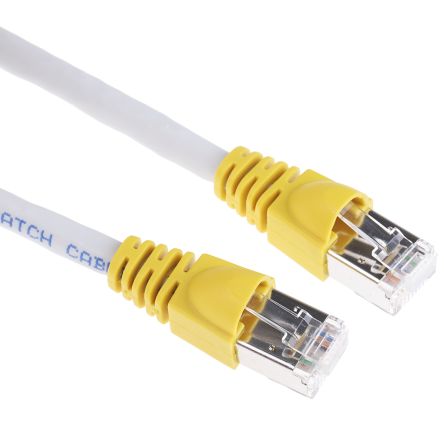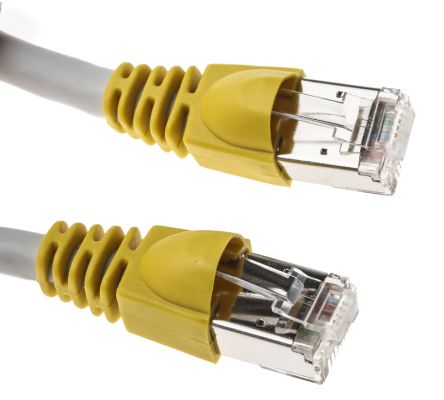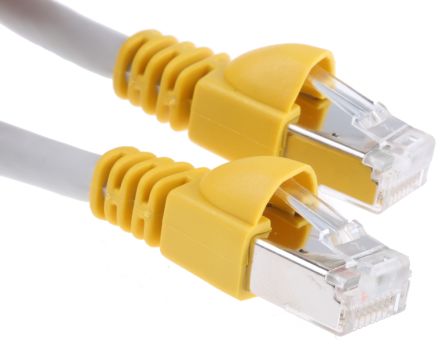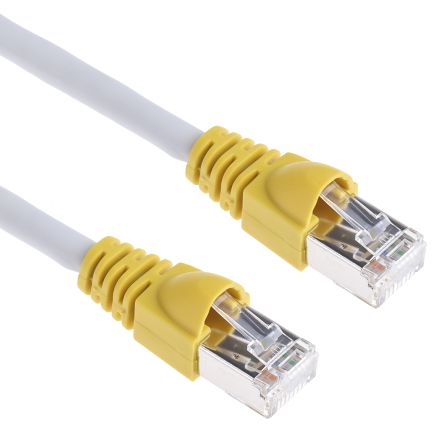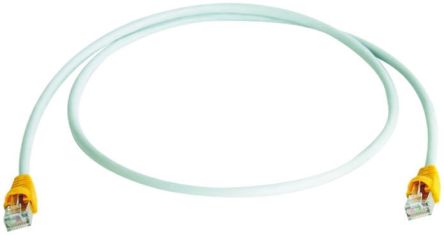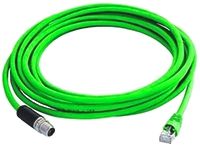- Automation & Control Gear
- Cables & Wires
- Enclosures & Server Racks
- Fuses & Circuit Breakers
- HVAC, Fans & Thermal Management
- Lighting
- Relays & Signal Conditioning
- Switches
- Batteries & Chargers
- Connectors
- Displays & Optoelectronics
- ESD Control, Cleanroom & PCB Prototyping
- Passive Components
- Power Supplies & Transformers
- Raspberry Pi, Arduino, ROCK, STEM Education & Development Tools
- Semiconductors
Telegartner Ethernet Cable
Ethernet cables are physical cables that are used to connect devices in a wired local area network (LAN). They are commonly used in Malaysia to establish a wired connection between computers, routers, network switches, and other networked devices. Ethernet cables are essential for transmitting data, such as internet traffic, between devices within a network.
Key Features and Benefits of Ethernet Cables?
Ethernet cables are the backbone of wired network connections, offering reliable and high-speed data transmission. Here are the key features and benefits of Ethernet cables:
- Physical Design: Ethernet cables typically consist of twisted pairs of copper wires encased in a protective outer sheath. The most common type of Ethernet cable is known as "Category 5e" (Cat 5e) or "Category 6" (Cat 6). Cat 5e cables can handle speeds up to 1 gigabit per second (Gbps), while Cat 6 cables can support speeds up to 10 Gbps. The twisted pair design helps minimise electromagnetic interference and crosstalk.
- Connectors: Ethernet cables use connectors called "RJ-45 connectors" at each end. These connectors have eight pins that make contact with the eight wires inside the cable. They are designed to snap into Ethernet ports on devices, ensuring a stable connection.
- Ethernet Standards: Ethernet cables adhere to various standards, such as 10BASE-T, 100BASE-TX, and 1000BASE-T, which specify the maximum data transfer speeds they can support. Newer standards like 10GBASE-T support even faster data rates for high-performance networks.
- Cable Length: Ethernet cables have a maximum recommended length, which depends on the specific standard and cable quality. For example, Cat 5e cables should not exceed 100 metres (about 328 feet) in length for optimal performance. Longer cable runs may require signal boosters or repeaters to maintain data integrity.
- **PoE (Power over Ethernet): **Some Ethernet cables support Power over Ethernet, allowing both data and electrical power to be transmitted over the same cable. This is often used to power devices like IP cameras, VoIP phones, and wireless access points without the need for separate power cables.
- Colour Coding: Ethernet cables often follow a colour-coding scheme for the wires inside. The most common colour code is TIA/EIA-568-B, which specifies the order of wire pairs within the cable. This colour coding aids in proper cable termination and troubleshooting.
- Shielding Options: Ethernet cables come in both unshielded (UTP) and shielded (STP) varieties. Shielded cables offer better protection against electromagnetic interference, making them ideal for industrial environments or areas with high electrical noise.
- Flexibility and Durability: Ethernet cables are designed to be flexible, allowing for easy installation in various environments. Many cables feature durable outer jackets that protect against wear and tear, making them suitable for both indoor and outdoor use.
Types of Ethernet Cables
Here are some of the most common types of Ethernet cables:
Cat 5e (Category 5e)
Cat 5e cables are among the most used Ethernet cables. They support data transfer speeds of up to 1 gigabit per second (Gbps) and are suitable for most home and small office network applications.
Cat 6 (Category 6)
Cat 6 Ethernet cables are an improvement over Cat 5e and can handle higher data transfer speeds, up to 10 gigabits per second (Gbps) over shorter distances.
Cat 6a (Category 6a)
Cat 6a cables, also known as Cat 6 Augmented, offer even higher data transfer speeds, up to 10 Gbps over longer distances than Cat 6 cables.
Cat 7 (Category 7)
Cat 7 cables are designed for high-speed networking and offer data transfer speeds of up to 10 Gbps.
Cat 8 (Category 8)
Cat 8 cables are the latest addition to Ethernet cable categories and are designed for extremely high-speed data transfer.
Cat 8.1 (Category 8.1)
Cat 8.1 is a variant of Cat 8 cables designed for use in residential and commercial applications. It supports data transfer speeds of up to 25 Gbps.
Industrial Application of Ethernet Cable
Here are the common industrial applications of Ethernet cable:
Automation System
In automation systems, Ethernet cables provide the reliable and high-speed communication necessary for interconnected devices like photoelectric sensors, actuators, programmable logic controllers (PLCs), and robots to work seamlessly together. This real-time data exchange enables efficient control, monitoring, and optimisation of automated processes, leading to increased productivity and reduced downtime.
Manufacturing Plants
In manufacturing plants, Ethernet cables help in connecting machines, equipment, and control systems across the production floor. They facilitate the exchange of data related to production parameters, quality control, inventory management, and supply chain logistics. This streamlines operations, enhances efficiency, and improves overall productivity in the manufacturing process.
Process Control Systems
Process control systems rely on Ethernet cables for the accurate and timely transmission of data between sensors, temperature controllers, and actuator cables. This ensures precise control and monitoring of critical parameters like temperature, pressure, flow rate, and level in various industrial processes.
Frequently Asked Questions About Ethernet Cables
Is an Ethernet cable faster than Wi-Fi?
Yes, Ethernet cables generally offer faster and more consistent speeds than Wi-Fi due to their direct, wired connection. Wi-Fi speeds can fluctuate depending on distance, interference, and other factors, while Ethernet provides a stable and reliable high-speed connection.
Which one is better, Cat5 or 6?
Cat6 is generally better than Cat5 due to its higher bandwidth and faster potential speeds. While Cat5 can handle up to 100 Mbps, Cat6 can support up to 10 Gbps. However, Cat5 has a lower price and is sufficient for most home and small office networks. You can buy the Ethernet cable depending on your specific speed and bandwidth requirements.
How do I know what Ethernet cable I have?
To identify your Ethernet cable, look for the markings printed on the cable's outer jacket. It should indicate the category (e.g., Cat5, Cat5e, Cat6) and potentially other details like shielding type (UTP or STP). If there are no markings, you can try visually comparing it to other cables or using a cable tester for more precise identification.
Delivery Information
Buy Ethernet cables for your LAN network available for sale online at RS and get them delivered conveniently and reliably. Choose the next working day delivery for urgent needs or select a specific day within the next 12 months for planned projects. To know more about the cost of Ethernet cables and their delivery price, visit our Delivery Page.
Explore the new look of the category page
12 Products showing for Telegartner Ethernet Cable
Popular Searches
- 10m Ethernet Cable
- 50m Ethernet Cable
- Belden Cat7 Cable
- Cat 6a Cables
- Cat 7 Ethernet Cables
- White Ethernet Cable
- Yellow Ethernet Cable
- amphenol ethernet cable
- belden ethernet cable
- harting ethernet cable
- lapp ethernet cable
- legrand ethernet cable
- omron ethernet cable
- phoenix contact ethernet cable
- schneider electric ethernet cable
- siemens ethernet cable
- telegartner ethernet cable
- turck ethernet cable
Related links
- Ethernet Connectors
- Network Testers
- RS PRO Green RJ45 to Male RJ45 Male Terminated PVC Sheath
- RS PRO Cable Tester Cat 5e Cat 6a LAN UTP
- Viavi Cable Tester Cat 5e Cat 6a LAN UTP
- Phoenix Contact D-LAN-CAT.5E-U Series RJ45 Female Adapter, Cat5e
- RS PRO Blue Unterminated PVC Sheath
- RS PRO Blue RJ45 to Male RJ45 Male Terminated PVC Sheath

